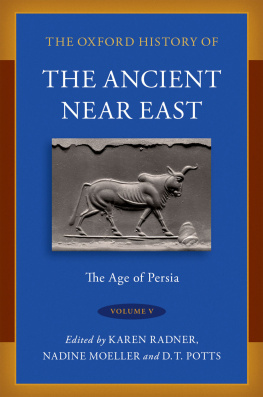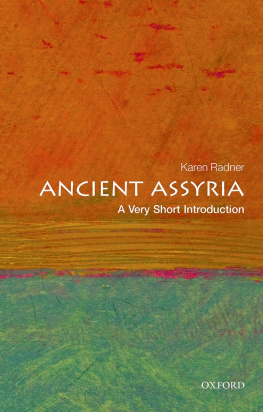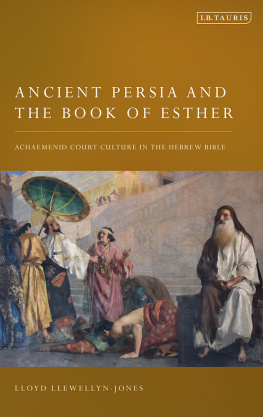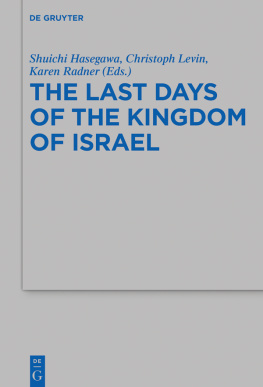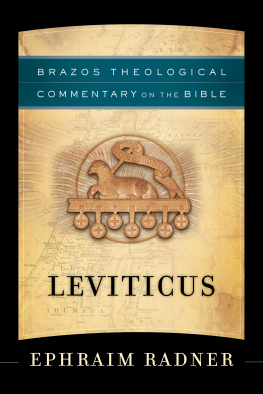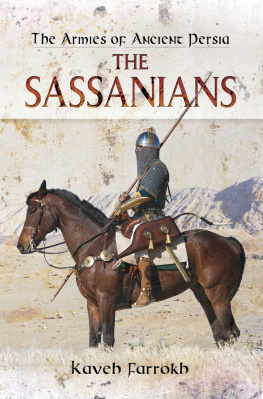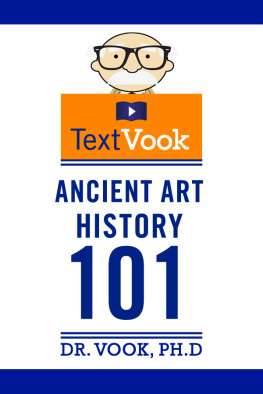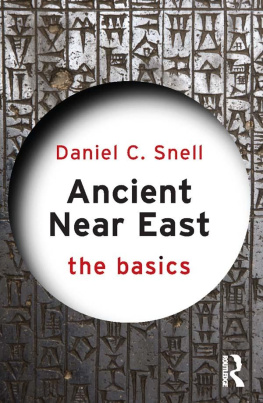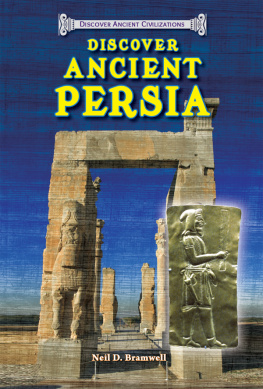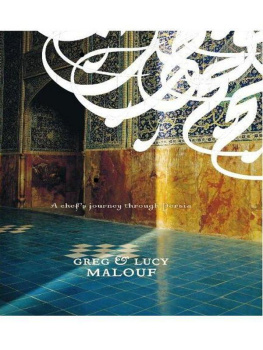Karen Radner - The Oxford History of the Ancient Near East: Age of Persia
Here you can read online Karen Radner - The Oxford History of the Ancient Near East: Age of Persia full text of the book (entire story) in english for free. Download pdf and epub, get meaning, cover and reviews about this ebook. year: 2023, publisher: Oxford University Press, Incorporated, genre: Art. Description of the work, (preface) as well as reviews are available. Best literature library LitArk.com created for fans of good reading and offers a wide selection of genres:
Romance novel
Science fiction
Adventure
Detective
Science
History
Home and family
Prose
Art
Politics
Computer
Non-fiction
Religion
Business
Children
Humor
Choose a favorite category and find really read worthwhile books. Enjoy immersion in the world of imagination, feel the emotions of the characters or learn something new for yourself, make an fascinating discovery.
- Book:The Oxford History of the Ancient Near East: Age of Persia
- Author:
- Publisher:Oxford University Press, Incorporated
- Genre:
- Year:2023
- Rating:3 / 5
- Favourites:Add to favourites
- Your mark:
- 60
- 1
- 2
- 3
- 4
- 5
The Oxford History of the Ancient Near East: Age of Persia: summary, description and annotation
We offer to read an annotation, description, summary or preface (depends on what the author of the book "The Oxford History of the Ancient Near East: Age of Persia" wrote himself). If you haven't found the necessary information about the book — write in the comments, we will try to find it.
The Oxford History of the Ancient Near East: Age of Persia — read online for free the complete book (whole text) full work
Below is the text of the book, divided by pages. System saving the place of the last page read, allows you to conveniently read the book "The Oxford History of the Ancient Near East: Age of Persia" online for free, without having to search again every time where you left off. Put a bookmark, and you can go to the page where you finished reading at any time.
Font size:
Interval:
Bookmark:

The Oxford History of the Ancient Near East
Editors: Karen Radner, Nadine Moeller, and D. T. Potts
This groundbreaking, five-volume series offers a comprehensive, fully illustrated history of Egypt and Western Asia (the Levant, Anatolia, Mesopotamia, and Iran), from the emergence of complex states to the conquest of Alexander the Great. Written by a highly diverse, international team of leading scholars, whose expertise brings to life the people, places, and times of the remote past, the volumes in this series focus firmly on the political and social histories of the states and communities of the ancient Near East. Individual chapters present the key textual and material sources underpinning the historical reconstruction, paying particular attention to the most recent archaeological finds and their impact on our historical understanding of the periods surveyed.
Volume 1: From the Beginnings to Old Kingdom Egypt and the Dynasty of Akkad
Volume 2: From the End of the Third Millennium bc to the Fall of Babylon
Volume 3: From the Hyksos to the Late Second Millennium bc
Volume 4: The Age of Assyria
Volume 5: The Age of Persia

Oxford University Press is a department of the University of Oxford. It furthers the Universitys objective of excellence in research, scholarship, and education by publishing worldwide. Oxford is a registered trade mark of Oxford University Press in the UK and certain other countries.
Published in the United States of America by Oxford University Press
198 Madison Avenue, New York, NY 10016, United States of America.
Oxford University Press 2023
All rights reserved. No part of this publication may be reproduced, stored in a retrieval system, or transmitted, in any form or by any means, without the prior permission in writing of Oxford University Press, or as expressly permitted by law, by license, or under terms agreed with the appropriate reproduction rights organization. Inquiries concerning reproduction outside the scope of the above should be sent to the Rights Department, Oxford University Press, at the address above.
You must not circulate this work in any other form and you must impose this same condition on any acquirer.
CIP data is on file at the Library of Congress
ISBN 9780190687663
eISBN 9780190687687
DOI: 10.1093/oso/9780190687663.001.0001
the fifth and final volume of the Oxford History of the Ancient Near East deals with the Persian Empire and its immediate predecessor states: Saite Egypt, the Neo-Babylonian Empire, and the kingdom of Lydia, as well as the kingdoms, chiefdoms, and tribal alliances shaping the political geography of the southern Levant and northern and southern Arabia, the roots of many of which go back to times covered by the previous volumes in this series. The areas covered include Egypt, Nubia and Ethiopia, the Caucasus, Anatolia and the Aegean, the Levant and the Arabian Peninsula, Mesopotamia and Iran, and for the first time in the series, Central Asia and the Indo-Iranian borderlands in what are today Afghanistan and Pakistan. The chronological scope of the volume extends from the second half of the seventh century bc until the campaigns of Alexander III of Macedon (336323 bc) brought an end to the Achaemenid Dynasty and the Persian Empire.
This books cover depicts the fifth and final specimen in our collection of beautiful cylinder seals selected from different parts of the Near East to grace the individual covers of the Oxford History of the Ancient Near East. The brown chalcedony seal from the collection of the Morgan Library & Museum, New York (accession number 0837) shows a solitary, striding zebu bull (Bos indicus). Acquired by Pierpont Morgan between 1885 and 1908, the seal shows an animal most often associated with South Asia, where the easternmost provinces of the Persian Empire were located. By the fifth century bc, however, when this seal was probably manufactured, the zebu was found across the Near East, and was thus no longer unfamiliar or exotic to the peoples of the region.
for a South Arabian example) but most of the written documentation was recorded on organic surfaces and materials that have not survived. As a consequence, these first chapters illustrate a wide range of approaches to history-writing as enabled, constrained, or demanded by the availability of sources and their respective challenges and advantages.
Such drastically different approaches also characterize the group of twelve chapters dealing with the Persian Empire, which was created by ), to the analysis of diverse expressions of material culture such as seals, coins, or pottery, to the interpretation of monumental, domestic, and funerary architecture. The final two chapters of the volume focus on the cultural and social history of the Persian Empire, on the one hand, and its interaction with the wider world, on the other hand, thus continuing a format already used in previous volumes for the most influential of the ancient Near Eastern states.
The following time chart presents a concise overview of the chronological coverage of this volume. The earlier parts of this chart may be consulted together with the time chart given in the fourth volume of the Oxford History of the Ancient Near East, as there is some chronological overlap.
Our editorial work on the Oxford History of the Ancient Near East was supported by the Center for Advanced Studies of LMU Munich (CASLMU), which awarded fellowships to Nadine Moeller and Dan Potts in July 2016, 2017, and 2018, and again in 2020 and 2021, although these could not be taken up because of the impact of the still ongoing COVID-19 (Sars-CoV-2) pandemic on travel and all forms of physical interaction. However, the weeks spent together in Munich in 20162018 enabled us to lay the groundwork that underpins this volume, in particular structuring the book and recruiting the scholars who would take on the individual chapters. Just as the previous volumes of the Oxford History of the Ancient Near East did, this book combines the talent and expertise of distinguished scholars from across the globe, each a recognized expert in their subject area, in order to offer new and often also complementary perspectives on the history of northeastern Africa, the eastern Mediterranean, the Middle East, and Central Asia from the seventh to the fourth century bc. We are fortunate that these scholars have made space in their busy schedules to contribute the seventeen chapters that constitute the present volume, covering The Age of Persia. Draft manuscripts for the chapters were received between May 2019 and August 2021. All of the joint editorial work on the chapters of this fifth volume had to be accomplished without the ability to meet and discuss issues in person. That the process was nevertheless productive and invariably smooth is owed to our joint GoogleDrive folders and our WhatsApp group, and to the trust and solid routines we have established in the five years since we started working on this large-scale publication project in 2016 at the behest of our friend and editor at Oxford University Press, Stefan Vranka.
In transcribing Egyptian proper nouns, we follow the conventions of The Oxford History of Ancient Egypt, edited by Ian Shaw (OUP 2004, rev. ed.). We do not use hyphenation to separate the components of Greek, Persian, and other Indo-European personal names, but we follow normal practice in marking the individual words within Akkadian proper nouns (e.g., Bel-uuru; Nab-tattannu-uur). Whenever a person or place is widely known by a conventional spelling, we use that (e.g., Nabopolassar instead of Nab-aplu-uur, Nebuchadnezzar instead of Nab-kudurr-uur, Cutha instead of Kutiu). We do not use long vowels in proper nouns, including modern Arabic and Farsi place names. The abbreviations used for classical authors and their works follow
Font size:
Interval:
Bookmark:
Similar books «The Oxford History of the Ancient Near East: Age of Persia»
Look at similar books to The Oxford History of the Ancient Near East: Age of Persia. We have selected literature similar in name and meaning in the hope of providing readers with more options to find new, interesting, not yet read works.
Discussion, reviews of the book The Oxford History of the Ancient Near East: Age of Persia and just readers' own opinions. Leave your comments, write what you think about the work, its meaning or the main characters. Specify what exactly you liked and what you didn't like, and why you think so.

